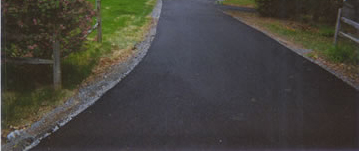 Maintaining asphalt is much more than maintaining that deep,
jet-black color. Both concrete and asphalt drives age, but unlike
concrete, asphalt can be rejuvenated and kept alive with proper
maintenance.
Maintaining asphalt is much more than maintaining that deep,
jet-black color. Both concrete and asphalt drives age, but unlike
concrete, asphalt can be rejuvenated and kept alive with proper
maintenance.Maintenance of an asphalt drive involves three basic
things: (1) replacing or patching sections of asphalt that are
failing or have failed, (2) cleaning and filling the cracks, and (3)
sealing the asphalt as a solid unit.
Water is the enemy of an asphalt drive. So it stands to reason
that maintenance activities are concerned with preventing water from
penetrating the asphalt surface.

An asphalt drive that is showing its age can be grayed, cracked,
have sections that are thinning or areas that no longer have asphalt
in them. When the cracking is severe, it is called "gatoring"
because it takes on the appearance of the scales on an alligator's
back. Gatored sections cease to have any flexibility or strength,
and they allow water to penetrate below the asphalt surface. Gatored
areas are on their way to the next phase of aging: asphalt thinning
and death.
Asphalt thinning comes about when there is little left to keep
the aggregate bound together. Asphalt death is when there is no
binding left and what you have left is black or gray gravel.

Dead sections of asphalt should be cut out and replaced. Some
people choose to patch potholes that have resulted from gatoring. A
very good patch material is available at Logan County Hardware. It
has smaller aggregate (rocks) and it sticks together really well.
After filling the hole, you are instructed to run over the fill with
your car tire to press it down. The whole idea is to prevent further
erosion by keeping the water out.
Some asphalt companies apply a thin veneer of asphalt to the top
of failed or failing asphalt, creating a "bump." But the better
solution is replacement.
When you have severe areas such as dead asphalt or gatoring, it
may be best to work with an asphalt maintenance expert, such as John
Barrick of Barrick Enterprises. Barrick specializes in maintaining
and restoring asphalt drives and parking lots, with the right
equipment, techniques and materials. He approaches dead asphalt by
cutting out the area and installing new asphalt. Barrick is
meticulous in making the whole job appear as though it was never
patched in the first place, and given the lasting quality of his
work and the price of the materials if purchased at retail, Barrick
may be a real bargain.
When doing it yourself, the second step in maintaining asphalt
drives is to clean out all the cracks and then fill them so that the
surface becomes waterproof. All the weeds and dirt need to come out
of the cracks for a superior seal. Pressure washers may be used, but
one must be careful not to inflict more damage while cleaning.
Barrick's workers use a special "crack-cleaning" tool with a wire
brush that gets out all the weeds, moss and dirt, preparing for
sealing. Gatored areas may be sealed or replaced as necessary.